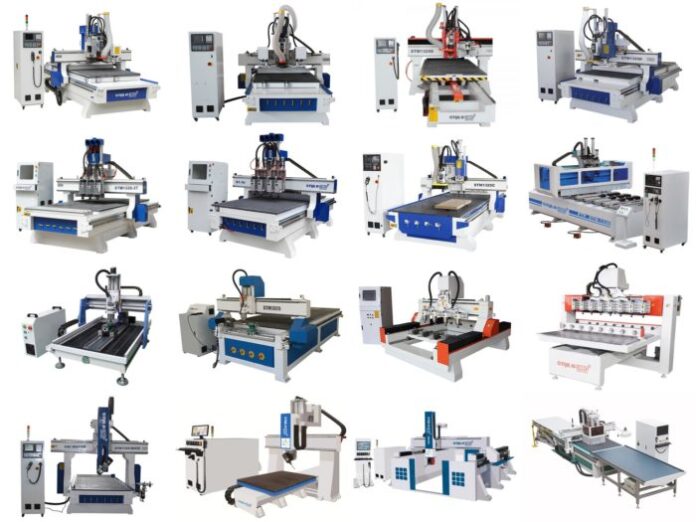Today, the industry is unthinkable without modern CNC (Computer Numerical Control) machines. CNC machines have almost the same parts as previous, manually controlled ones. The essential difference is the addition of a control (CNC) unit and servo motor to all axles.
The CNC calculates the coordinates of where the shaft should be and controls the servo motors that move the tool or workpiece. Generally, most CNC manufacturers buy control units that they put into their machines. One of the most famous and widespread control units in the world are Fanuc from Japan, Siemens and Heidenhain from Germany … The most famous manufacturers of CNC are, again, companies from Germany and Japan.
In industrial practice, the following programming methods are applied: manual programming, semi-automatic programming (drive), automated (computer-aided) programming.
The set of all necessary instructions collected in a single file on the basis of which the machine executes the part processing is called NC program, CNC program or subprogram. The program is a detailed set of instructions, commands (step by step) that relate to defining the position of the cutting tool relative to the workbench of the machine on which the subject of the processing is fixed.
Manual programming

That involves the printing of programs by technologists manually, ie. each sentence, part of the program, is written according to the defined technology. Computer-aided programming (computer-aided) means the automated programming of specific program sequences, automated by the application of specialized software on a computer. A technologist programmer defines parameters such as dimensions, tool selection, processing modes, etc. The specialized software used for programming are: CATIA, MASTERCAM, SOLIDCAM and others.
CNC evolved from NC (numerically controlled ) where information was not stored as whole programs in control but partially loaded from drilled tapes. The development of CNC technology began around the mid-1970s. This made it possible to rationalize in mass and individual production, through significantly faster and more precise movements of axes and tools.
Today, the industry is almost unthinkable without modern CNC. The scope of their application is very wide. They can be used for wood, metal, plastic, stone, glass, engraving, toolmaking, modeling, tool making…
Using a suitable CNC program, the model we want to create is translated into machine-understandable language. That language or G-code actually generates the coordinates of each point that the tool knife has to cross. Read more into this here – Summit’s Guide to CNC programming.
The process

Idea and creativity have always been the start of any business. Problems always, as everyone says, arise with the realization of an idea. With CNC technology, you will definitely find it much easier to get from the idea to the product, but there are several steps involved. From the vision of the idea must come the graphic solution, the product design. When a design solution is converted to the format required, such as CAD, CAM, then it is converted to the machine language or G code we mentioned, and it forms a text file consisting of a set of control commands. “Translating” or converting the graphic design into the language of a machine is a way to direct its movements in order to obtain a product to a specified specification.
Many manufacturers’ training is not complicated, and the manufacturers themselves or their distributors, with the purchased one, provide you with training in handling. But as with any production, there are simple and complex ones, so it depends on how you operate them. For more complex ones, experts are hired to hold training hours on particular machinery in production and to familiarize employees with all the features of the software.
In addition to being controlled by a computer program, the CNC consists of a machine (milling, lathe, router), a matching engine, driver, computer and software package. There are CNC routers and CNC milling machines and lathes.
CNC routers

They are CNC of smaller and lighter construction and are used for engraving and processing of softer materials, such as media plan, chipboard, plywood, plastic. These ones are fast and have a high speed, and because of their smaller dimensions and speed, they are suitable for smaller workshops and smaller production. You can see various router models here.
CNC milling machines and lathes
These are heavy and massive machinery that are used to process wood, light and heavy metals by cutting ie. scraping and milling. They are used in large production facilities and in terms of price and size, as well as performance, it is immediately clear that they are used in massive batch production.
The idea of production automation was developed by the Industrial Revolution, although back then, for the owners of manufacturing plants, human labor was much more profitable than investing in the development of it. According to many experts, not only was this a problem but in order to realize the idea of such machines, a certain technological level was needed.
Basic differences between CNC and NC

NC operates so that one motor drives both the main spindle and other work table movements, while the CNCs have one (main) motor for the main spindle drive, and the axial movement is accomplished by special DC motors.
For NC type, the operation is performed manually or mechanically through the control levers, while CNC has a control unit (keyboard and display) and operates automatically through the program specified in the computer.
It is definitely that the job is facilitated both physically and financially with their use. To know exactly which CNC machinery you need, you need to look at a few things, from the job you do, through the space you have, production plans, markets, employees who need to be trained in using it, choosing the best deal, but not just the price but also based on the manufacturer, who, in addition to the warranty, can provide training, service and technical support so that production and jobs are not much downtimes in the event of a problem. Of course, you should also consider the budget you have for investing in all that. Given that CNC technology is precision technology, the possibility of error is minimized and is mainly due to the human factor and since they can be in operation 24 hours a day, with occasional maintenance shutdowns.
Price
It depends on the manufacturer’s brand and the complexity of it and the performance it has, right down to the accessories. These ones have been evolving every day in parallel with new technologies and it has been a constant evolution since the industrial revolution.

Conclusion:
However, all the results show that these machines are very profitable and quickly return the money invested. Of course, in addition to such a machine, in order to be cost-effective, reduce production costs and quick return on investment, you must have a very good and realistic business plan. It goes without saying that it is also necessary to do good research on the market and the offers that the manufacturers of these machines have.









